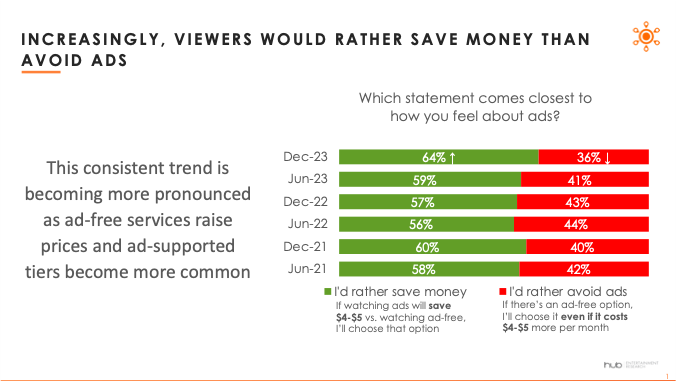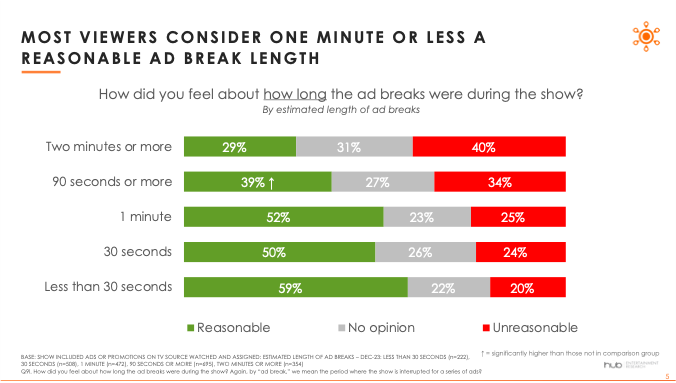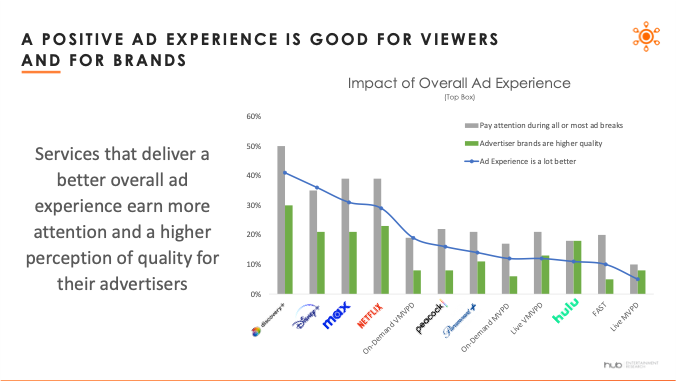Hub’s annual 2023 report “TV Advertising: Fact vs. Fiction” found that of 3,000 surveyed U.S. consumers between 14-74, the majority are softening their stance on cheaper, ad-supported streaming options to keep their monthly streaming bills under control. The findings come as several streamers have raised prices on ad-free tiers and introduced lower-cost plan options that have commercials.
Approximately two-thirds of respondents said that they would choose an ad-supported plan if it could hit the sweet spot of $4 to $5 in savings per month. In June 2022, consumers hit a peak of anti-ad fervor with 44% of respondents stating that they would pay $4 to $5 more per month for a streaming service if it meant no ad time. By December 2023, that figure fell to 36%, an 8 point downward shift in the willingness of users to pay to avoid ads.
Meanwhile, December 2023 was also the survey peak of consumers reporting that the bottom line of their monthly bills was more important than an ad-free experience. Of respondents, 64% said that they’d rather save that same $4 to $5 per subscription per month by watching ads, an eight percentage point jump in a year and a half from June 2022.
 Source: Hub Entertainment Research
Source: Hub Entertainment ResearchEven the self-described “ad-intolerant” crowd is changing their tune. In December 2022, 26% of respondents who self-reported as ad-intolerant prioritized saving money over avoiding ads. One year later, that figure has climbed to its two-year high at 35%, a sign that even “ad-intolerant” households see ads as a tradeoff for savings.
Consumers prefer ad breaks short and sweet
Even for changing ad preferences, consumers resoundingly prefer short, sweet ads — they’ll even pay more attention to them.
About 38% of consumers reported they would choose one streaming service over another if it offered a lighter ad-load (meaning shorter breaks and/or fewer ads), with the threshold of acceptable ad break length clocking in at under 60 seconds. In fact, 46% of respondents stated they’re more likely to pay attention to ads if A) their ad break all-in is shorter and B) the specific ad creative itself is also shorter in length. Once an ad break tips over the 90 second mark, consumer approval plummets.
 Source: Hub Entertainment Research
Source: Hub Entertainment ResearchIn fact, consumers tend to view advertisers on services with more reasonable ad loads as higher quality. Of surveyed platforms, Discovery+, Disney+, Max, and Netflix received the highest correlations between a better ad experience and the perception of higher-quality advertiser brands as well as consumers paying attention to ad breaks.
 Source: Hub Entertainment Research
Source: Hub Entertainment ResearchHowever, despite launches of ad-supported plans by many major streamers like Disney+, Netflix, and later this month Amazon’s Prime Video, a significant percentage of consumers don’t know that there are ad-supported options for some of their favorite streaming services. Of the surveyed platforms, Discovery+, Max and Paramount+ were among those with the least amount of consumer awareness that there are less expensive ad-supported plans to stream their respective content.
As the wider acceptance of advertising in exchange for lower monthly streaming bills grows, Hub noted that services have opportunities for “aggressive marketing” of cheaper plans to get would-be customers who haven’t added a streaming platform due to perceived high costs to sign up to an ad-supported tier.
Plus, with most streaming services generally adhering to ad loads consumers find acceptable, the report noted brands have an opportunity to get ads in front of audiences that pay more attention and view them more favorably. According to Hub, streaming is now a better advertising message environment than traditional linear TV.
“As consumers begin to get hit with the double whammy of needing multiple subscriptions to get their entertainment, coupled with significant price increases, opting in for advertising becomes more appealing to them,” said Mark Loughney, a senior consultant to Hub in the published report. “As long as providers stick to reasonable ad loads, it’s a win for them and their advertisers as well.”
The changing consumer sentiment around ads could be good news for Amazon Prime Video, which is slated to launch ads for all of its Prime customers on January 29. Subscribers seeking to conserve ad-free content will have to pay $2.99 more per month on top of Amazon Prime's monthly $14.99 subscription cost.
Source: streamtvinsider.com

